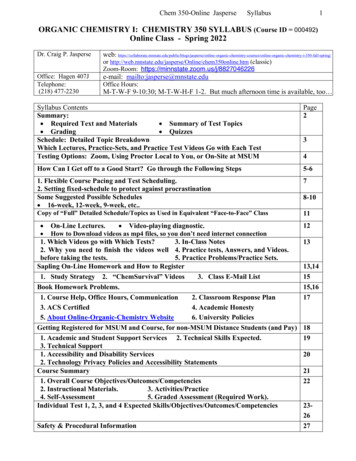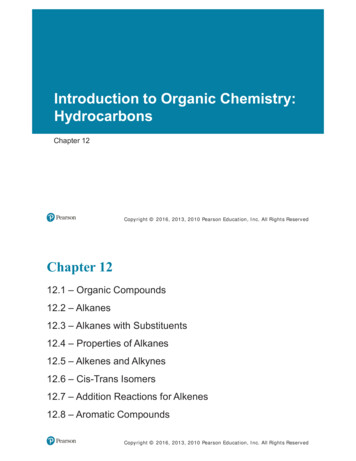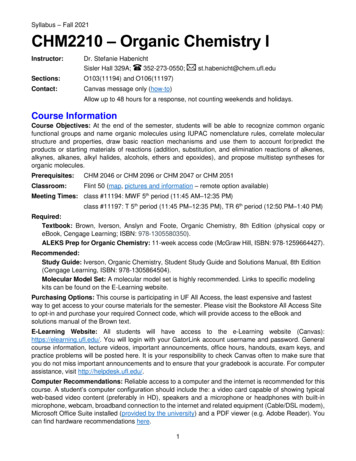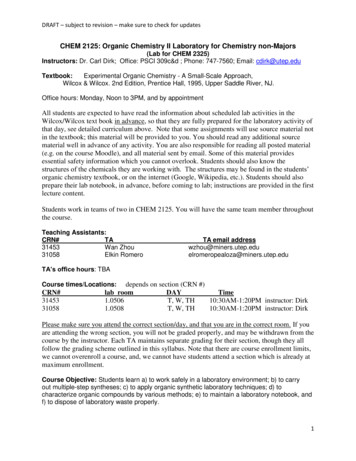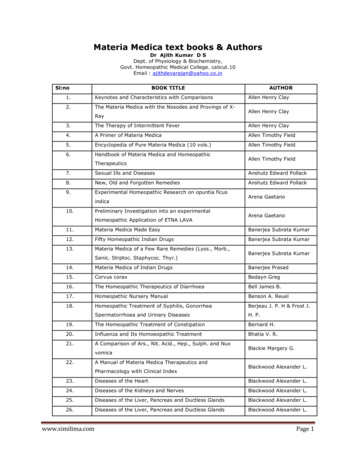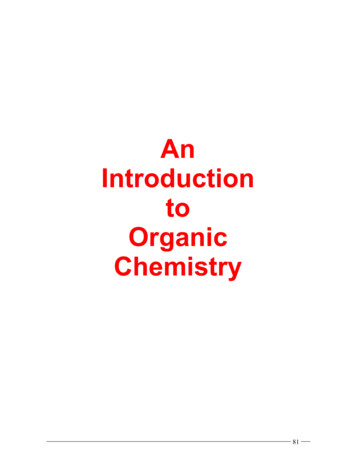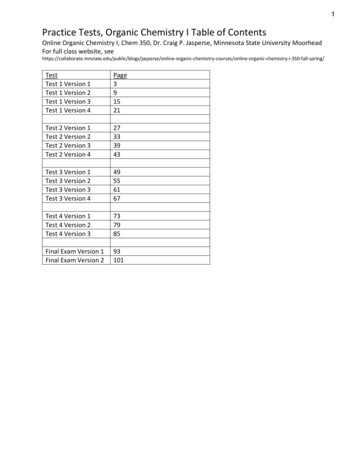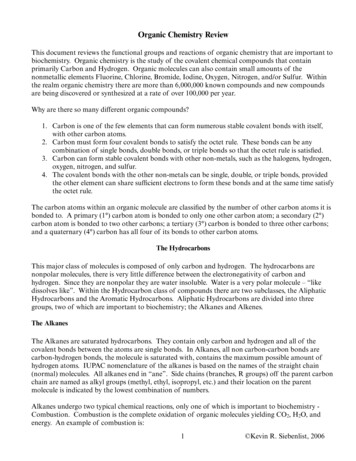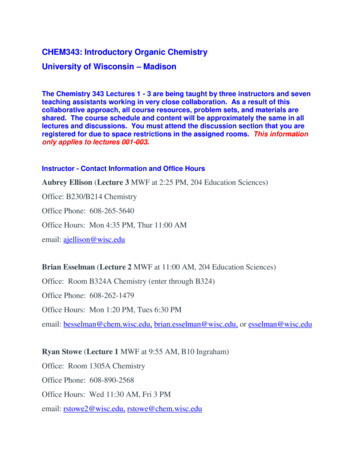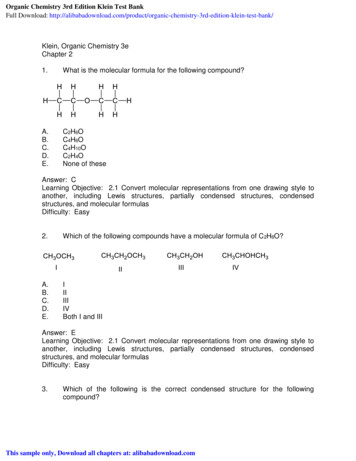
Transcription
Organic Chemistry 3rd Edition Klein Test BankFull Download: ry-3rd-edition-klein-test-bank/Klein, Organic Chemistry 3eChapter 21.What is the molecular formula for the following compound?A.B.C.D.E.C2H6OC4H6OC4H10OC2H4ONone of theseAnswer: CLearning Objective: 2.1 Convert molecular representations from one drawing style toanother, including Lewis structures, partially condensed structures, condensedstructures, and molecular formulasDifficulty: Easy2.Which of the following compounds have a molecular formula of C 2H6O?A.B.C.D.E.IIIIIIIVBoth I and IIIAnswer: ELearning Objective: 2.1 Convert molecular representations from one drawing style toanother, including Lewis structures, partially condensed structures, condensedstructures, and molecular formulasDifficulty: Easy3.Which of the following is the correct condensed structure for the followingcompound?This sample only, Download all chapters at: alibabadownload.com
CH2CH2OCH3CH3CH3CHCH2OHAnswer: CLearning Objective: 2.1 Convert molecular representations from one drawing style toanother, including Lewis structures, partially condensed structures, condensedstructures, and molecular formulasDifficulty: Easy4.Which of the following is the correct condensed structure for the HClCH3C2H4CH3OHClAnswer: BLearning Objective: 2.1 Convert molecular representations from one drawing style toanother, including Lewis structures, partially condensed structures, condensedstructures, and molecular formulasDifficulty: Easy5.Which of the following is the correct condensed structure for the followingcompound?
A.B.C.D.E.CH2 CH(CH2)3C(CH3)3CH(CH2)4C(CH3)3(CH3)2CH(CH2) 4CH3CH2CH(CH2)3C(CH3)3(CH)3(CH2)3C(CH3)3Answer: ALearning Objective: 2.1 Convert molecular representations from one drawing style toanother, including Lewis structures, partially condensed structures, condensedstructures, and molecular formulasDifficulty: Medium6.Which of the following is the correct condensed structure for the C(CH2)3C(CH3)2CH3(CH3)3C2(CH2)3CH3CH3C C(CH2)3C(CH3)3CH3CC(CH2)3C(CH3)3Answer: DLearning Objective: 2.1 Convert molecular representations from one drawing style toanother, including Lewis structures, partially condensed structures, condensedstructures, and molecular formulasDifficulty: Medium
7.Which of the following is the correct condensed structure for the BrCH(CH3)2Answer: ELearning Objective: 2.1 Convert molecular representations from one drawing style toanother, including Lewis structures, partially condensed structures, condensedstructures, and molecular formulasDifficulty: Medium8.Provide the correct condensed structure for the following compound.Answer: (CH3)3C(CH2)2OCH(CH2CH3)2Learning Objective: 2.1 Convert molecular representations from one drawing style toanother, including Lewis structures, partially condensed structures, condensedstructures, and molecular formulasDifficulty: Hard9.Provide the correct condensed structure for the following compound.
Answer: (CH3)2N(CH2)3CH(CH3)2Learning Objective: 2.1 Convert molecular representations from one drawing style toanother, including Lewis structures, partially condensed structures, condensedstructures, and molecular formulasDifficulty: Hard10.Which of the following is the correct molecular formula for r: CLearning Objective: 2.1 Convert molecular representations from one drawing style toanother, including Lewis structures, partially condensed structures, condensedstructures, and molecular formulasDifficulty: Easy11.Which of the following is the correct Lewis structure for CH3(CH2)2NH2?
A.B.C.D.E.IIIIIIIVBoth II and IIIAnswer: CLearning Objective: 2.1 Convert molecular representations from one drawing style toanother, including Lewis structures, partially condensed structures, condensedstructures, and molecular formulasDifficulty: Easy12.Which of the following is the correct Lewis structure for CH3(CH2)2OH?A.B.C.D.E.IIIIIIIVBoth II and IIIAnswer: BLearning Objective: 2.1 Convert molecular representations from one drawing style toanother, including Lewis structures, partially condensed structures, condensedstructures, and molecular formulasDifficulty: Easy13.Which of the following is the correct Lewis structure for (CH3)2CHCH2OH?
A.B.C.D.E.IIIIIIIVBoth III and IVAnswer: CLearning Objective: 2.1 Convert molecular representations from one drawing style toanother, including Lewis structures, partially condensed structures, condensedstructures, and molecular formulasDifficulty: Easy14.Which of the following is the correct Lewis structure for (CH3)3C(CH2)2NHCH3?
A.B.C.D.E.IIIIIIIVVAnswer: DLearning Objective: 2.1 Convert molecular representations from one drawing style toanother, including Lewis structures, partially condensed structures, condensedstructures, and molecular formulasDifficulty: Medium15.Draw the Lewis structure for CH3C C(CH2)3C(CH3)3.Answer:Learning Objective: 2.1 Convert molecular representations from one drawing style toanother, including Lewis structures, partially condensed structures, condensedstructures, and molecular formulasDifficulty: Medium
16.Draw the Lewis structure for (CH3)3C(CH2)2OCH(CH2CH3)2.Answer:Learning Objective: 2.1 Convert molecular representations from one drawing style toanother, including Lewis structures, partially condensed structures, condensedstructures, and molecular formulasDifficulty: Hard17.Identify the partially condensed structure for CH3CH2OCH2CH3.A.B.C.D.E.IIIIIIIVVAnswer: ALearning Objective: 2.1 Convert molecular representations from one drawing style toanother, including Lewis structures, partially condensed structures, condensedstructures, and molecular formulasDifficulty: Easy
18.Identify the partially condensed structure for CH3CH2CH2NH2.Answer: ALearning Objective: 2.1 Convert molecular representations from one drawing style toanother, including Lewis structures, partially condensed structures, condensedstructures, and molecular formulasDifficulty: Easy19.Which of the following bond-line structures are of the same compound?A.B.C.D.E.I and IIII and IIIIII and IVII and IVNone of theseAnswer: DLearning Objective: 2.2 Demonstrate how to read and draw bond-line structuresthrough converting other styles of molecular representation into bond-line structures andvice versaDifficulty: Easy20.Which of the following bond-line structures are of the same compound?
A.B.C.D.E.I and IIIII and IIIIII and IVII and IVNone of theseAnswer: ALearning Objective: 2.2 Demonstrate how to read and draw bond-line structuresthrough converting other styles of molecular representation into bond-line structures andvice versaDifficulty: Easy21.How many hydrogen atoms are connected to the indicated carbon atom?A.B.C.D.E.onetwothreefournoneAnswer: ELearning Objective: 2.2 Demonstrate how to read and draw bond-line structuresthrough converting other styles of molecular representation into bond-line structures andvice versaDifficulty: Easy22.How many hydrogen atoms are connected to the indicated carbon atom?A.B.onetwo
C.D.E.threefournoneAnswer: ALearning Objective: 2.2 Demonstrate how to read and draw bond-line structuresthrough converting other styles of molecular representation into bond-line structures andvice versaDifficulty: Easy23.How many hydrogen atoms are connected to the indicated carbon atom?A.B.C.D.E.onetwothreefournoneAnswer: BLearning Objective: 2.2 Demonstrate how to read and draw bond-line structuresthrough converting other styles of molecular representation into bond-line structures andvice versaDifficulty: Easy24.How many hydrogen atoms are connected to the indicated carbon atom?A.B.C.D.E.onetwothreefournoneAnswer: A
Learning Objective: 2.2 Demonstrate how to read and draw bond-line structuresthrough converting other styles of molecular representation into bond-line structures andvice versaDifficulty: Easy25.How many hydrogen atoms are connected to the indicated carbon atom?A.B.C.D.E.onetwothreefournoneAnswer: ELearning Objective: 2.2 Demonstrate how to read and draw bond-line structuresthrough converting other styles of molecular representation into bond-line structures andvice versaDifficulty: Easy26.For the following equation, how many hydrogen atoms are added or lost?A.B.C.D.E.added oneadded twolost onelost twono changeAnswer: DLearning Objective: 2.2 Demonstrate how to read and draw bond-line structuresthrough converting other styles of molecular representation into bond-line structures andvice versaDifficulty: Easy
27.For the following equation, how many hydrogen atoms are added or lost?A.B.C.D.E.added oneadded twolost onelost twono changeAnswer: BLearning Objective: 2.2 Demonstrate how to read and draw bond-line structuresthrough converting other styles of molecular representation into bond-line structures andvice versaDifficulty: Easy28.For the following equation, how many hydrogen atoms are added or lost?A.B.C.D.E.added oneadded twolost onelost twono changeAnswer: ELearning Objective: 2.2 Demonstrate how to read and draw bond-line structuresthrough converting other styles of molecular representation into bond-line structures andvice versaDifficulty: Easy29.For the following equation, how many hydrogen atoms are added or lost?
A.B.C.D.E.added oneadded twolost onelost twono changeAnswer: ELearning Objective: 2.2 Demonstrate how to read and draw bond-line structuresthrough converting other styles of molecular representation into bond-line structures andvice versaDifficulty: Easy30.For the following equation, how many hydrogen atoms are added or lost?A.B.C.D.E.added oneadded twolost onelost twono changeAnswer: DLearning Objective: 2.2 Demonstrate how to read and draw bond-line structuresthrough converting other styles of molecular representation into bond-line structures andvice versaDifficulty: Medium31.For the following equation, how many hydrogen atoms are added or lost?
A.B.C.D.E.added oneadded twolost onelost twono changeAnswer: ELearning Objective: 2.2 Demonstrate how to read and draw bond-line structuresthrough converting other styles of molecular representation into bond-line structures andvice versaDifficulty: Medium32.Which of the following is the correct Lewis structure for the following compound?A.B.C.D.E.IIIIIIIVnone of theseAnswer: BLearning Objective: 2.2 Demonstrate how to read and draw bond-line structuresthrough converting other styles of molecular representation into bond-line structures andvice versaDifficulty: Easy
33.Which of the following is the correct bond-line structure for (CH3)4C?A.B.C.D.E.IIIIIIIVNone of theseAnswer: CLearning Objective: 2.2 Demonstrate how to read and draw bond-line structuresthrough converting other styles of molecular representation into bond-line structures andvice versaDifficulty: Easy34.Which of the following is the correct bond-line structure for (CH3)2CHCH2CH3?A.B.C.D.E.IIIIIIIVNone of theseAnswer: ALearning Objective: 2.2 Demonstrate how to read and draw bond-line structuresthrough converting other styles of molecular representation into bond-line structures andvice versaDifficulty: Easy
35.Which of the following(CH3)2CHCH2C(CH3)3?A.B.C.D.E.IIIIIIIVNone of theseisthecorrectbond-linestructureforAnswer: BLearning Objective: 2.2 Demonstrate how to read and draw bond-line structuresthrough converting other styles of molecular representation into bond-line structures andvice versaDifficulty: Medium36.Which of the followingCH3C C(CH2)2CH(CH3)2?A.B.C.D.E.IIIIIIIVNone of theseisthecorrectbond-linestructureforAnswer: DLearning Objective: 2.2 Demonstrate how to read and draw bond-line structuresthrough converting other styles of molecular representation into bond-line structures andvice versaDifficulty: Medium
37.Which of the following isCH3CHOH(CH2)2CH(CH2CH3) orAnswer: BLearning Objective: 2.2 Demonstrate how to read and draw bond-line structuresthrough converting other styles of molecular representation into bond-line structures andvice versaDifficulty: Medium38.Draw a bond-line structure for CH3CH2O(CH2)2CH(CH3)2.Answer:Learning Objective: 2.2 Demonstrate how to read and draw bond-line structuresthrough converting other styles of molecular representation into bond-line structures andvice versaDifficulty: Hard
39.Draw a bond-line structure for (CH3)2N(CH2)3CH(CH3)2.Answer:Learning Objective: 2.2 Demonstrate how to read and draw bond-line structuresthrough converting other styles of molecular representation into bond-line structures andvice versaDifficulty: Hard40.Draw a bond-line structure for CH3C C(CH2)3C(CH3)2CH2OCH3.Answer:Learning Objective: 2.2 Demonstrate how to read and draw bond-line structuresthrough converting other styles of molecular representation into bond-line structures andvice versaDifficulty: Hard41.Draw a bond-line structure for each constitutional isomer with a molecularformula of C2H4O.Answer:Learning Objective: 2.2 Demonstrate how to read and draw bond-line structuresthrough converting other styles of molecular representation into bond-line structures andvice versaDifficulty: Hard42.Draw a bond-line structure for each constitutional isomer with a molecularformula of C3H8O.
Answer:Learning Objective: 2.2 Demonstrate how to read and draw bond-line structuresthrough converting other styles of molecular representation into bond-line structures andvice versaDifficulty: Hard43.Provide a condensed structure for the following compound.Answer: (CH3)3CCH2CH(CH2CH3)(CH2)2CH(CH3)CH2CH3Learning Objective: 2.2 Demonstrate how to read and draw bond-line structuresthrough converting other styles of molecular representation into bond-line structures andvice versaDifficulty: Hard44.Provide a condensed structure for the following compound.Answer: (CH3)3C(CH2)2CH(NH2)CH CHCH3Learning Objective: 2.2 Demonstrate how to read and draw bond-line structuresthrough converting other styles of molecular representation into bond-line structures andvice versaDifficulty: Hard
45.Draw a bond-line structure for each constitutional isomer with molecular formulaC4H10O.Answer:Learning Objective: 2.2 Demonstrate how to read and draw bond-line structuresthrough converting other styles of molecular representation into bond-line structures andvice versaDifficulty: Hard46.Draw a bond-line structure for each constitutional isomer with molecular formulaC4H11N.Answer:Learning Objective: 2.2 Demonstrate how to read and draw bond-line structuresthrough converting other styles of molecular representation into bond-line structures andvice versaDifficulty: Medium47.Naproxen, sold under the trade name Aleve, has the following structure. What isthe molecular formula for naproxen?
Answer: C14H14O3Learning Objective: 2.2 Demonstrate how to read and draw bond-line structuresthrough converting other styles of molecular representation into bond-line structures andvice versaDifficulty: Hard48.AZT, used in the treatment of AIDS, has the following structure. What is themolecular formula for AZT?Answer: C10H13N5O4Learning Objective: 2.2 Demonstrate how to read and draw bond-line structuresthrough converting other styles of molecular representation into bond-line structures andvice versaDifficulty: Hard49.Capsaicin, found in peppers, has the following structure. What is the molecularformula for capsaicin?
Answer: C18H27NO3Learning Objective: 2.2 Demonstrate how to read and draw bond-line structuresthrough converting other styles of molecular representation into bond-line structures andvice versaDifficulty: Hard50.Which of the following compounds contain an alcohol functional group?A.B.C.D.E.IIIIIIIVNone of theseAnswer: CLearning Objective: 2.3 Identify and draw the functional groupsDifficulty: Easy51.Which of the following compounds contain an alkene functional group?
A.B.C.D.E.IIIIIIIVNone of theseAnswer: ALearning Objective: 2.3 Identify and draw the functional groupsDifficulty: Easy52.Which of the following compounds contain an amine functional group?A.B.C.D.E.IIIIIIIVNone of theseAnswer: DLearning Objective: 2.3 Identify and draw the functional groupsDifficulty: Easy53.Which of the following compounds contain a ketone functional group?
A.B.C.D.E.IIIIIIIVAll of theseAnswer: ALearning Objective: 2.3 Identify and draw the functional groupsDifficulty: Easy54.Which of the following compounds contain an aromatic ring?A.B.C.D.E.IIIIIIIVBoth III and IVAnswer: CLearning Objective: 2.3 Identify and draw the functional groupsDifficulty: Easy55.Which of the following compounds contain an ester functional group?
A.B.C.D.E.IIIIIIIVBoth I and IVAnswer: ALearning Objective: 2.3 Identify and draw the functional groupsDifficulty: Easy56.Which of the following compounds contain an amide functional group?A.B.C.D.E.IIIIIIIVBoth II and IIIAnswer: BLearning Objective: 2.3 Identify and draw the functional groupsDifficulty: Easy57.Which of the following compounds contain an anhydride functional group?A.B.C.D.E.IIIIIIIVnone of the aboveAnswer: CLearning Objective: 2.3 Identify and draw the functional groups
Difficulty: Easy58.Which of the following compounds contain an alkyne functional group?A.B.C.D.E.IIIIIIIVnone of the aboveAnswer: ALearning Objective: 2.3 Identify and draw the functional groupsDifficulty: Easy59.Which of the following compounds contain a thiol functional group?A.B.C.D.E.IIIIIIIVnone of the aboveAnswer: BLearning Objective: 2.3 Identify and draw the functional groupsDifficulty: Easy60.Which of the following compounds contain an alkyl halide functional group?
A.B.C.D.E.IIIIIIIVnone of the aboveAnswer: DLearning Objective: 2.3 Identify and draw the functional groupsDifficulty: Easy61.What functional group(s) is (are) present in the following compound?A.B.C.D.E.ketone and alkeneketone and alkynealdehyde and alkenealdehyde and alkyneester and alkeneAnswer: CLearning Objective: 2.3 Identify and draw the functional groupsDifficulty: Medium62.Which of the following compounds have both a ketone and an ester functionalgroup?
A.B.C.D.E.IIIIIIIVVAnswer: ELearning Objective: 2.3 Identify and draw the functional groupsDifficulty: Medium63.Norethynodrel, a component of the first combined oral contraceptive, has thefollowing structure. Identify the functional groups in Norethynodrel.Answer:
Learning Objective: 2.3 Identify and draw the functional groupsDifficulty: Medium64.Identify the functional groups in the following compound.Answer:Learning Objective: 2.3 Identify and draw the functional groups
Difficulty: Medium65.Tamiflu , the most effective antiviral drug used to treat avian influenza, has thefollowing structure. Identify the functional groups in Tamiflu .Answer:Learning Objective: 2.3 Identify and draw the functional groupsDifficulty: Hard66.Aspartame, an artificial sweetener used in Equal and diet beverages, has thefollowing structure. Identify the functional groups in Aspartame.
Answer:Learning Objective: 2.3 Identify and draw the functional groupsDifficulty: Hard67.Draw all the constitutional isomers with a molecular formula of C3H6O and labelthe functional groups in each isomer.Answer:
Learning Objective: 2.3 Identify and draw the functional groupsDifficulty: Hard68.Amoxicillin, an antibiotic, has the following structure. Identify the functionalgroups in amoxicillin.Answer:Learning Objective: 2.3 Identify and draw the functional groupsDifficulty: Hard69.Viracept, used in the treatment of HIV, has the following structure. Identify thefunctional groups in Viracept.
Answer:Learning Objective: 2.3 Identify and draw the functional groupsDifficulty: Hard70.How many hydrogen atoms are connected to the indicated carbon atom?
A.B.C.D.E.onetwothreefournoneAnswer: BLearning Objective: 2.4 Identify formal charges on carbonDifficulty: Easy71.How many hydrogen atoms are connected to the indicated carbon atom?A.B.C.D.E.onetwothreefournoneAnswer: ELearning Objective: 2.4 Identify formal charges on carbonDifficulty: Easy72.How many hydrogen atoms are connected to the indicated carbon atom?A.B.C.D.E.onetwothreefournoneAnswer: ALearning Objective: 2.4 Identify formal charges on carbon
Difficulty: Easy73.How many hydrogen atoms are connected to the indicated carbon atom?A.B.C.D.E.onetwothreefournoneAnswer: BLearning Objective: 2.4 Identify formal charges on carbonDifficulty: Easy74.How many hydrogen atoms are connected to the indicated carbon atom?A.B.C.D.E.onetwothreefournoneAnswer: ELearning Objective: 2.4 Identify formal charges on carbonDifficulty: Easy75.How many hydrogen atoms are connected to the indicated carbon atom?
A.B.C.D.E.onetwothreefournoneAnswer: ALearning Objective: 2.4 Identify formal charges on carbonDifficulty: Easy76.What is the formal charge on the indicated carbon atom?A.B.C.D.E.-2-10 1 2Answer: DLearning Objective: 2.4 Identify formal charges on carbonDifficulty: Easy77.What is the formal charge on the indicated carbon atom?A.B.C.D.E.-2-10 1 2Answer: DLearning Objective: 2.4 Identify formal charges on carbonDifficulty: Easy
78.What is the formal charge on the indicated carbon atom?A.B.C.D.E.-2-10 1 2Answer: DLearning Objective: 2.4 Identify formal charges on carbonDifficulty: Easy79.What is the formal charge on the indicated carbon atom?A.B.C.D.E.-2-10 1 2Answer: BLearning Objective: 2.4 Identify formal charges on carbonDifficulty: Easy80.What is the formal charge on the indicated carbon atom?A.-2
B.C.D.E.-10 1 2Answer: BLearning Objective: 2.4 Identify formal charges on carbonDifficulty: Easy81.What is the formal charge on the indicated carbon atom?A.B.C.D.E.-2-10 1 2Answer: BLearning Objective: 2.4 Identify formal charges on carbonDifficulty: Easy82.What is the formal charge on the oxygen atom in the following compound?A.B.C.D.E. 1 2-1-20Answer: ALearning Objective: 2.5 Describe the relationship between the number of bonds, thenumber of lone pairs, and formal charge for oxygen and nitrogen atomsDifficulty: Easy
83.What is the formal charge on the nitrogen atom in the following compound?A.B.C.D.E.-1-2 1 20Answer: CLearning Objective: 2.5 Describe the relationship between the number of bonds, thenumber of lone pairs, and formal charge for oxygen and nitrogen atomsDifficulty: Easy84.What is the formal charge on the nitrogen atom in the following compound?A.B.C.D.E. 1 2-1-20Answer: ALearning Objective: 2.5 Describe the relationship between the number of bonds, thenumber of lone pairs, and formal charge for oxygen and nitrogen atomsDifficulty: Easy85.What is the formal charge on the indicated oxygen atom in the followingcompound?
A.B.C.D.E. 1 2-1-20Answer: ELearning Objective: 2.5 Describe the relationship between the number of bonds, thenumber of lone pairs, and formal charge for oxygen and nitrogen atomsDifficulty: Easy86.What is the formal charge on the nitrogen atom in the following compound?A.B.C.D.E. 1 2-1-20Answer: ELearning Objective: 2.5 Describe the relationship between the number of bonds, thenumber of lone pairs, and formal charge for oxygen and nitrogen atomsDifficulty: Easy87.Which of the following compounds have 1 as a formal charge on an oxygenatom?A.B.III
C.D.E.IIIIVBoth I and IVAnswer: BLearning Objective: 2.5 Describe the relationship between the number of bonds, thenumber of lone pairs, and formal charge for oxygen and nitrogen atomsDifficulty: Medium88.Which of the following compounds have 1 as a formal charge on the nitrogenatom?A.B.C.D.E.IIIIIIIVBoth I and IIAnswer: DLearning Objective: 2.5 Describe the relationship between the number of bonds, thenumber of lone pairs, and formal charge for oxygen and nitrogen atomsDifficulty: Medium89.Determine the formal charges on each atom except hydrogen.Answer:
Learning Objective: 2.5 Describe the relationship between the number of bonds, thenumber of lone pairs, and formal charge for oxygen and nitrogen atomsDifficulty: Medium90.Diazomethane has the molecular formula CH2N2. Draw the preferred Lewisstructure for diazomethane and assign formal charges to all atoms excepthydrogen.Answer:Learning Objective: 2.5 Describe the relationship between the number of bonds, thenumber of lone pairs, and formal charge for oxygen and nitrogen atomsDifficulty: Hard91.Draw Lewis structure for the following compound.Answer:
Learning Objective: 2.5 Describe the relationship between the number of bonds, thenumber of lone pairs, and formal charge for oxygen and nitrogen atomsDifficulty: Medium92.How many lone pairs of electrons are on the oxygen atom?A.B.C.D.E.onetwothreefournoneAnswer: CLearning Objective: 2.5 Describe the relationship between the number of bonds, thenumber of lone pairs, and formal charge for oxygen and nitrogen atomsDifficulty: Easy93.How many lone pairs of electrons are on the nitrogen atom?A.B.C.D.E.onetwothreefournoneAnswer: B
Learning Objective: 2.5 Describe the relationship between the number of bonds, thenumber of lone pairs, and formal charge for oxygen and nitrogen atomsDifficulty: Easy94.How many lone pairs of electrons are on the oxygen atom?A.B.C.D.E.onetwothreefournoneAnswer: BLearning Objective: 2.5 Describe the relationship between the number of bonds, thenumber of lone pairs, and formal charge for oxygen and nitrogen atomsDifficulty: Easy95.How many lone pairs of electrons are on the nitrogen atom?A.B.C.D.E.onetwothreefournoneAnswer: ALearning Objective: 2.5 Describe the relationship between the number of bonds, thenumber of lone pairs, and formal charge for oxygen and nitrogen atomsDifficulty: Easy
96.How many lone pairs of electrons are on the nitrogen atom?A.B.C.D.E.onetwothreefournoneAnswer: ELearning Objective: 2.5 Describe the relationship between the number of bonds, thenumber of lone pairs, and formal charge for oxygen and nitrogen atomsDifficulty: Easy97.How many lone pairs of electrons are on the indicated oxygen atom?A.B.C.D.E.onetwothreefournoneAnswer: BLearning Objective: 2.5 Describe the relationship between the number of bonds, thenumber of lone pairs, and formal charge for oxygen and nitrogen atomsDifficulty: Easy98.How many lone pairs of electrons are on the indicated oxygen atom?
A.B.C.D.E.onetwothreefournoneAnswer: ALearning Objective: 2.5 Describe the relationship between the number of bonds, thenumber of lone pairs, and formal charge for oxygen and nitrogen atomsDifficulty: Medium99.How many total lone pairs of electrons are in the following compound?A.B.C.D.E.onetwothreefournoneAnswer: CLearning Objective: 2.5 Describe the relationship between the number of bonds, thenumber of lone pairs, and formal charge for oxygen and nitrogen atomsDifficulty: Easy100.Draw all lone pairs of electrons for the following compound.
Answer:Learning Objective: 2.5 Describe the relationship between the number of bonds, thenumber of lone pairs, and formal charge for oxygen and nitrogen atomsDifficulty: Medium101.Draw all lone pairs of electrons for the following compound.Answer:
Learning Objective: 2.5 Describe the relationship between the number of bonds, thenumber of lone pairs, and formal charge for oxygen and nitrogen atomsDifficulty: Medium102.The indicated bond in the following compound is of the paper.A.B.C.D.in the planeout of the planebehind the planeNone of theseAnswer: BLearning Objective: 2.6 Describe how wedges and dashes are used to indicate threedimensional molecular structureDifficulty: Easy103.The indicated bond in the following compound is of the paper.A.B.C.D.in the planeout of the planebehind the planeNone of theseAnswer: CLearning Objective: 2.6 Describe how wedges and dashes are used to indicate threedimensional molecular structureDifficulty: Easy104.The indicated bond in the following compound is of the paper.
A.B.C.D.in the planeout of the planebehind the planeNone of theseAnswer: CLearning Objective: 2.6 Describe how wedges and dashes are used to indicate threedimensional molecular structureDifficulty: Easy105.Which of the following is a Fischer projection?A.B.C.D.E.IIIIIIIVBoth III and IVAnswer: BLearning Objective: 2.6 Describe how wedges and dashes are used to indicate threedimensional molecular structureDifficulty: Easy
106.Which of the following is a Haworth projection?A.B.C.D.E.IIIIIIIVBoth III and IVAnswer: CLearning Objective: 2.6 Describe how wedges and dashes are used to indicate threedimensional molecular structureDifficulty: Easy107.Label the bonds that are out of the plane and behind the plane of the paper.Answer:
Learning Objective: 2.6 Describe how wedges and dashes are used to indicate threedimensional molecular structureDifficulty: Medium108.Which of the following pairs are resonance structures of each other?A.B.C.D.E.IIIIIIIVNone of theseAnswer: DLearning Objective: 2.7 Define "resonance," describing the relationship betweenresonance and molecular orbital theoryDifficulty: Easy109.Which of the following pairs are resonance structures of each other?A.B.C.D.E.IIIIIIIVNone of theseAnswer: C
Learning Objective: 2.7 Define "resonance," describing the relationship betweenresonance and molecular orbital theoryDifficulty: Easy110.The spreading of positive or negative charge over two or more atoms in acompound is called ocalizationNone of theseAnswer: BLearning Objective: 2.7 Define "resonance," describing the relationship betweenresonance and molecular orbital theoryDifficulty: Easy111.Delocalization of charge over two or more atoms a sstabilizesNone of theseAnswer: DLearning Objective: 2.7 Define "resonance," describin
Klein, Organic Chemistry 3e Chapter 2 1. What is the molecular formula for the following compound? A. C 2 H 6 O B. C 4 H 6 O C. C 4 H 10 O D. C 2 H 4 O E. None of these Answer: C Learning Objective: 2.1 Convert molecular representations from one drawing style to another, including Le

